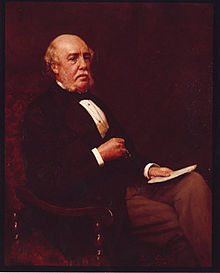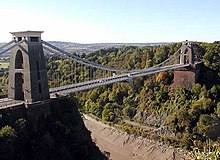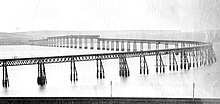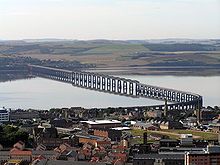William Henry Barlow
William Henry Barlow | |
|---|---|
 Barlow byJohn Collier,1880 | |
| Born | 10 May 1812 Woolwich,Kent, U.K. |
| Died | 12 November 1902(aged 90) Charlton, London,U.K. |
| Occupation | Engineer |
| Parent | Peter Barlow |
| Engineering career | |
| Discipline | Civil |
| Institutions | |
| Projects | |
| Significant design | Barlow rail |
William Henry BarlowFRSFRSEFICEMIMechE(10 May 1812 – 12 November 1902) was an Englishcivil engineerof the 19th century, particularly associated with railway engineering projects. Barlow was involved in many engineering enterprises. He was engineer for theMidland Railwayon its London extension and designed the company's London terminus atSt Pancras.
WithJohn Hawkshaw,he completedIsambard Kingdom Brunel'sClifton Suspension Bridge.Following theTay Bridge disasterhe sat on the commission which investigated the causes and designed the replacementTay Bridge.Barlow was also an inventor and experimenter, patenting a design for a rail and carrying out investigations on the use and design of steel structures.
Early life and education
[edit]Barlow was born on 10 May 1812 inWoolwich,Kent (now in south-east London), the son of mathematician and physicist ProfessorPeter Barlow,who taught at theRoyal Military Academyin Woolwich. William Barlow was the younger brother ofPeter William Barlow.[1]After a private education, Barlow began to study civil engineering with his father at the age of sixteen. After a year he, went on to apupillageat the machinery department of theRoyal Navy'sWoolwich Dockyardclose to his family home. He then worked at theLondon DocksforHenry Robinson Palmer.[1]
Barlow married Selina Crawford Caffin in May 1842 atCharlton, Kent.[2]The couple had four sons and two daughters. Their son Crawford Barlow became a civil engineer and was in practice with his father.[1]
Career
[edit]From 1832 he spent six years working as an engineer inConstantinople,Ottoman Empire,helping build an ordnance factory on behalf of machine tool manufacturersMaudslay, Sons & Field.He also produced a report for the Turkish government onlighthousesin theBosphorus,which led to his first two scientific papers.[1][note 1]For his services to the Ottoman government he was awarded the Order of Nishan Iftikhar (Order of Glory).[1]
Barlow returned to Britain in 1838 to take up a post as assistant engineer on theManchester and Birmingham Railwayworking forGeorge W. Buck.In 1842, he joined theMidland Counties Railwayas resident engineer for the section betweenRugbyandDerby.When the Midland Counties Railway became part of theMidland Railwayin 1844, he retained the position, later becoming chief engineer of the larger railway. On 1 April 1845, Barlow was elected a member of theInstitution of Civil Engineersand on 6 June 1850 he was elected aFellowof theRoyal Society.[1]

Whilst working on the Midland Railway's main line, Barlow established that the replacement ofsleeperswas a larger part of the cost of track maintenance than the replacement of rails because the sleepers decayed more quickly than the rails wore-out and needed renewal more often.[3]To remove the cost of providing and replacing sleepers, he developed and patented his own rail design in 1849. It had a wide flanged profile which could be laid directly on totrack ballastwithout the need for sleepers, with just periodic tie-bars to maintain the correctgauge.[note 2]Known as theBarlow rail,it was widely used, especially by the Great Western Railway.[1]
Joseph Paxton,designer of thecast ironand glassCrystal PalaceforThe Great Exhibitionof 1851, was a director of the Midland Railway and he asked Barlow for his help in the preparation of the structural calculations for the frame of the building.[1]

In 1857, Barlow left the Midland Railway to form his own consultant engineering practice in London, with the Midland Railway as a significant client.[1]Following the death ofIsambard Kingdom Brunelin 1859, Barlow was commissioned withJohn Hawkshawto complete theClifton Suspension Bridge,Bristol, construction of which had been stalled since 1843 due to insufficient funds to finish it. Reusing the chains from Brunel's earlierHungerford Suspension Bridgein London, demolished in 1860, Barlow and Hawkshaw completed the bridge in 1864 with a more robust deck than Brunel had planned and other variations caused by the reuse of the existing chains.[4]Its 702-foot (214 m) span was the longest in Britain at the time.[1]
Between 1862 and 1869, Barlow was consultant engineer for the Midland Railway's southern extension fromBedfordto London, including the layout of the London terminus station atSt PancrasonEuston Road.To deal with the sloping site and the need to cross theRegent's Canala short distance to the north, the platforms were constructed on a raised structure supported on cast iron columns and girders. Under this structure, storage was laid out for beer from the breweries atBurton upon Trent.[5]With assistance fromRowland Mason Ordish,[6]Barlow also designed the arched, cast iron station canopy which spans 240 feet (73 m) across the platforms without intermediate support – then the widest of its kind in the world. It was designed as a cost-effective and efficient means of avoiding the need for additional solid structure in the lower level.[7]George Gilbert Scottdesigned the hotel in front of the train shed.[6]


On 28 December 1879, the central section of theNorth British Railway's bridge across theRiver TaynearDundeecollapsed in theTay Bridge disasteras an express train crossed it in a heavy storm. All 75 passengers and crew on the train were killed. As the newly elected President of the Institution of Civil Engineers,[note 3]Barlow was appointed as a member of theBoard of Trade's Court of Inquiry into the disaster. He sat withHenry Cadogan RotheryandWilliam Yolland,co-authoring one of the final reports with Yolland recommending a commission be established to examine wind loads on bridges. In its report dated 30 June 1880, the Court of Inquiry concluded that the bridge, designed bySir Thomas Bouchand opened only the year before its collapse, had been "badly designed, badly built and badly maintained".[9]The entire centralbox trusssection of the bridge known as the "High Girders" collapsed along with the thirteentrestlessupporting it, leaving a gap of nearly half-a-mile in the 2-mile-long (3.2 km) bridge.
His reputation destroyed, Bouch died in October 1880. Work on thesuspension bridgehe had designed to cross theFirth of Forthwas stopped after the Tay Bridge collapse and Barlow,Sir John FowlerandThomas Elliot Harrison,consultant engineers for the three railway companies involved in the construction, were asked to choose a replacement design. The solution was thecantileveredForth Bridgeby Fowler andSir Benjamin Baker.[1]
In 1881 Barlow sat as member of the Wind Pressure (Railway Structures) Commission established at the recommendation of the Tay Bridge report.[10]He led the design of the replacementTay Bridge(1882–87) with his son Crawford Barlow as engineer.[1]The new design used largemonocoquepiers to support a double railway track. The old brick and masonry piers from the first bridge were retained asbreakwatersfor the new piers upstream. They can still be seen today as a forlorn reminder of the tragedy of 1879.
Barlow was an early experimenter with civil engineering uses for steel, carrying out research at Woolwich Arsenal in the 1850s and being a member of the Institution of Civil Engineers' committee on the subject. From 1873 he was a member of a Board of Trade committee which produced the first recommendations on safe working loads for steel in railway structures in 1877.[1]
Barlow also experimented with sound recording. In February 1874 he presented theRoyal Societywith a talkOn the Pneumatic Action which accompanies the Articulation of Sounds by the Human Voice, as exhibited by a Recording Instrument.[11]He called his 'recording instrument' aLogograph.[12][13]
Barlow was a Fellow of theRoyal Society of Edinburgh,a member of theInstitution of Mechanical Engineersand theSociety of Arts.He served as Vice President of the Royal Society in 1881 and was an honorary member of the Société des Ingénieurs Civil de France. He was also aLieutenant-Colonelin theRailway Volunteer Staff Corps.[1][14]
With his health failing, he retired from practice in 1896, along with his son. He died on 12 November 1902 from exhaustion after breaking his leg,[1]and was buried inCharlton Cemeteryin a plot adjacent to that of his father's grave. His home "High Combe", Charlton Road, Greenwich, is marked with ablue plaque.[15]
Notes and references
[edit]Notes
[edit]- ^Barlow's first papers wereExperiments made at Constantinople on Drummond's light(1836) andThe adaptation of different modes of illuminating lighthouses as depending on their situations and the object contemplated in their erection(1837).[1]
- ^Barlow's patent for the rail was no. 12438, 1849.[1]
- ^Barlow was elected president of the Institution of Civil Engineers on 23 December 1879, five days before the disaster.[8]
References
[edit]- ^abcdefghijklmnopqChrimes 2008.
- ^"Married".West Kent Guardian.14 May 1842. p. 8.
- ^Barlow 1850,p. 7.
- ^Barlow 1867,pp. 243–244.
- ^Barlow 1870,pp. 79 and 83.
- ^abBarlow 1870,p. 82.
- ^Barlow 1870,pp. 85–89.
- ^"Institution of Civil Engineers".The Times.25 December 1879. p. 9.Retrieved26 January2011.
- ^Rothery 1880,p. 44.
- ^Hawkshaw et al. 1881.
- ^Barlow 1874.
- ^Preece 1878,pp. 536–37.
- ^Bramwell 1884,pp. 28–30.
- ^Who Was Who 2007.
- ^"Barlow, William Henry".English Heritage.Retrieved22 July2015.
Bibliography
[edit]- Barlow, William Henry (1850)."On the Construction of the Permanent Way of Railways: With An Account of the Wrought-Iron Permanent Way Laid Down on the Main Line of the Midland Railway".Excerpt Minutes of the Proceedings of the Institution of Civil Engineers.Institution of Civil Engineers.hdl:2027/mdp.39015021048007.Retrieved2 January2011.
- Barlow, William Henry (1867)."Description of the Clifton Suspension Bridge".Minutes of the Proceedings of the Institution of Civil Engineers.XXVI.Institution of Civil Engineers:243–257.doi:10.1680/imotp.1867.23161.
- Barlow, William Henry (1870)."Description of the St Pancras Station and Roof, Midland Railway".Minutes of the Proceedings of the Institution of Civil Engineers.XXX.Institution of Civil Engineers:78–105.doi:10.1680/imotp.1870.23014.
- Barlow, William Henry (1874)."On the Pneumatic Action which accompanies the Articulation of Sounds by the Human Voice, as exhibited by a Recording Instrument".Proceedings of the Royal Society of London.XXII.Royal Society.Retrieved29 July2011.
- Bramwell, Frederick(1884)."The practical applications of electricity: a series of lectures delivered at the Institution of Civil Engineers, session 1882–83".Institution of Civil Engineers:28.Retrieved29 July2011.
The practical applications of electricity.
{{cite journal}}:Cite journal requires|journal=(help) - Chrimes, Mike (2008)."Barlow, William Henry (1812–1902)".Oxford Dictionary of National Biography(online ed.). Oxford University Press.doi:10.1093/ref:odnb/30598.Retrieved24 December2010.(Subscription orUK public library membershiprequired.)
- Hawkshaw, John;Armstrong, W G;Barlow, W H;Stokes, G G;Yolland, W(1881)."Wind Pressure (Railway Structures) Commission"(PDF).Her Majesty's Stationery Office.
- Rothery, Henry(1880)."Report of the Court of Inquiry and Report of Mr Rothery Upon the Circumstances attending the Fall of a Portion of the Tay Bridge on the 28th December 1879"(PDF).Her Majesty's Stationery Office.
- Preece, William Henry(1878)."The Phonograph".Journal of the Society of Arts.XXVI.Retrieved29 July2011.
- "Barlow, William Henry".Who Was Who.Oxford University Press/A & C Black.December 2007.Retrieved26 January2011.
Further reading
[edit]- Lewis, Peter R. (2004).Beautiful Railway Bridge of the Silvery Tay: Reinvestigating the Tay Bridge Disaster of 1879.Tempus.ISBN0-7524-3160-9.
- 1812 births
- 1902 deaths
- Engineer and Railway Staff Corps officers
- English civil engineers
- Fellows of the Royal Society
- Fellows of the Royal Society of Edinburgh
- People from Charlton, London
- People associated with transport in London
- Presidents of the Institution of Civil Engineers
- Presidents of the Smeatonian Society of Civil Engineers
- Midland Railway people


